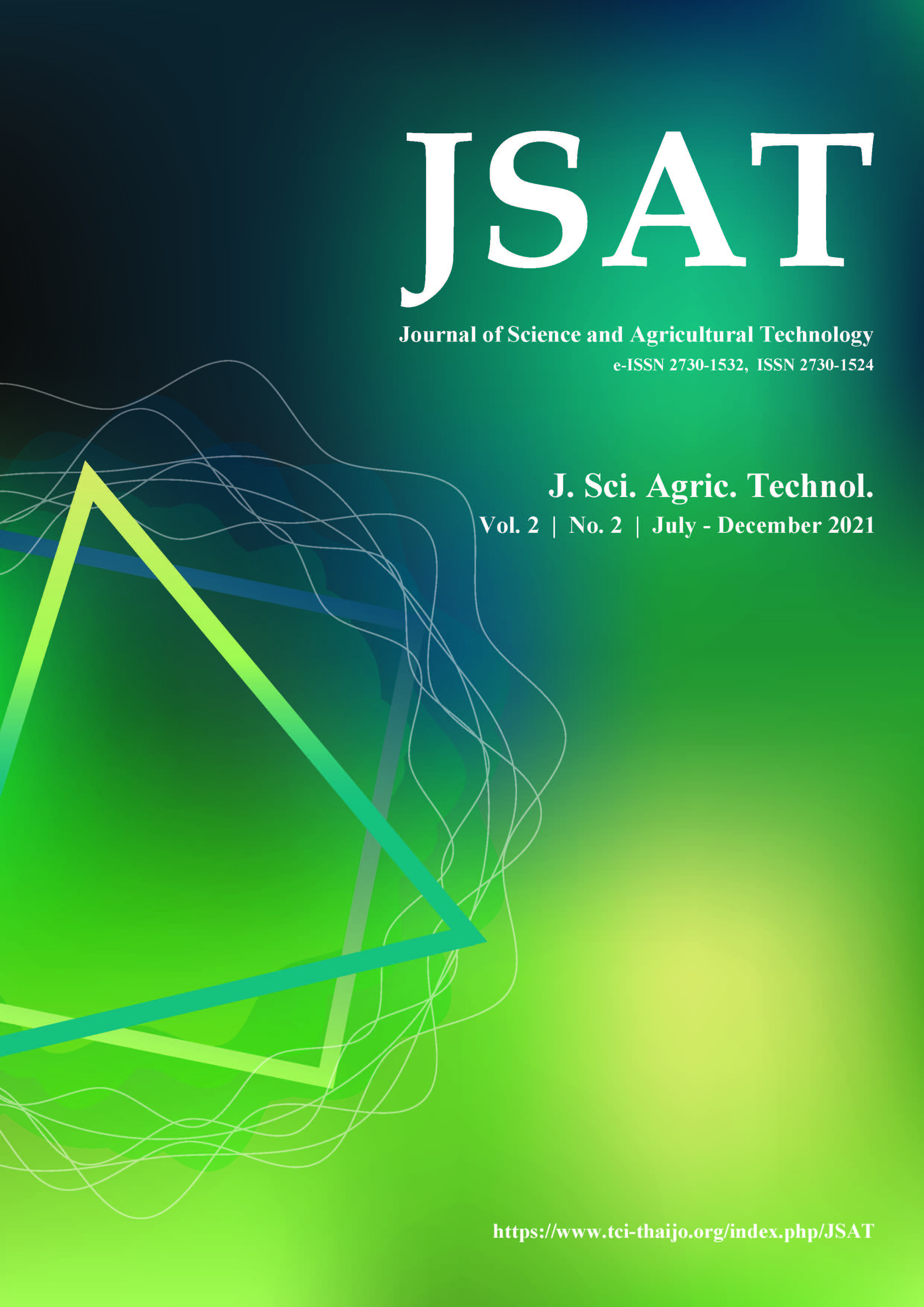The use of different levels of mulberry leaf meal with the broken-riceberry-based diet for semi-free range layers
Main Article Content
Abstract
The present study investigated the effect of semi-free range laying hen fed dietary mulberry leaf meal mixed plus broken riceberry on egg performance, egg quality, and health. A randomized complete block experimental design was assigned, which block was a housing model (sunshine and shade). One hundred sixty laying hens (59 weeks of age) were divided into four groups in each house (20 birds of each group). The laying hens in each group were randomly assigned to 4 dietary treatments as follows: Diet 1, 2, 3, and 4, which were used broken riceberry as an energy source and mixed with 0, 2, 4, and 6 % sun-dried mulberry leaf meal, respectively. There were two consecutive 28 day periods to collect data based on egg production and egg quality. In the last period, the feces of each group were randomly collected to determine the number of microorganisms (total plate count, coliform, salmonella, and lactic acid bacteria). The results showed that there were no statistical differences among the four groups on egg production percentage, daily feed intakes, feed conversion ratio per 1 kilogram of egg weight, feed cost per 1 kilogram of egg weight, egg weight, albumen height, haugh unit, eggshell thickness, and the number of coliforms and lactic acid bacteria in feces (P>0.05). However, the egg yolk color scores were the highest, followed by diet 3, 2, and 1, respectively (P<0.05). The total plate count and salmonella in the feces of the laying hen fed with diet 4 were the lowest (P<0.05). In addition, feed cost per 1 kilogram of egg weight of the group fed with diet 4 was slightly lower than other groups.
Article Details
References
Agriculture Editor. 2014. Riceberry new varieties of fragrant rice changing the lives of Thai farmers. Panyachon Publisher, Bangkok.
Al-kirshi, R., Alimon, A.R., Zulkifli, I., Sazili, A., Zahari, M. W., and Ivan, M. 2010. Utilization of mulberry leaf meal (Morus alba) as protein supplement in diets for laying hens. Ital J Anim Sci. 9 (51): 265 – 267.
AOAC. 2000. Association of Office Analytical Chemist. 17thed. Association of Official Chemist, Inc. Washington, D.C.
Bharani, S.E., Asad, M., Dhamanigi, S.S., and Chandrakala, G.K.. 2010. Immuno modulatory activity of methanolic extract of Morus alba Linn. (Mulberry) leaves. Pak. J. Pharm. Sci. 23:63-68.
Chalermsan, N., Kajitphetjarat, S., Kajitphetjarat, K., and Jaree, T. 2017. The use of riceberry broken rice mixed with moringa leaf meal in laying quails diets. Agricultural Sci. J. 4(2) (Suppl): 128-129.
Devi, B., Sharma, N., Kumar, D., and Jeet, K. 2013. Morus Alba Linn: A phytopharmacological review. Int. J. Pharm. Sci, 5: 14-18.
Downes, F.P., and Ito., K.2001. Compendium of Methods for the Microbiological Examination of 4th ed. America Public Health Association, Washington D.C.
Hamdan, H., Yunianto, V.D., and Sukamto, B. 2013. The effectivity of fermented mulberry leaves with rumen liquor as broiler feed on final body weight, dry matter and crude fiber digestibility, and metabolic energy. Anim. Prod. 15(3): 173-179.
Intralamongkol, J. 2010. Organic free range laying hen production. Organic Livestock Center. Breeding Division, Department of Livestock Development, Bangkok.
Kamruzzaman M.D., Rahman, M.S., Asaduzzaman, M.D., and Zaminur Rahman M.D. 2012. Significant effect of Mulberry leaf (Morus alba) meal in the reduction of egg-yolk cholesterol. Bangladesh Res. Pub. J. 7(2): 153-160.
Kamruzzaman. M., Khatun, M.A., Islam, M.S., Rahman, M.Z., and Yeasmin, T. 2014. Effect of dietary mulberry leaf meal on egg quality of laying hens. J. Sci Technol. 12: 12 – 17.
Moller, A.P., Biard, C., Blount, J.D., Houston, D.C., Ninni, P., Saino, N., and Surai, P.F. 2000. Carotenoid dependent signals: indicators of foraging efficiency, Immunocompetence or detoxification ability?. Avian Poult. Biol. Rev. 11 (3):137- 159.
NRC. 1994. Nutrient Requirements of Poultry 9th Revised Ed. Academy of Sciences, Wachington DC. Omidiran, M.O., Baiyewu, R.A., Ademola, I.T., Fakorede, O.C., Toyinbo, E.O., Adewumi, O.J., and Adekunle, E.A. 2012. Phytochemical analysis, nutritional composition and antimicrobial activities of white mulberry (Morus alba). Pak J Nutr. 11(5): 456-460.
Sarita, S., Rashmi, K., Anju, T., and Prakash, R. 2006. Nutritional quality of leaves of some genotypes of mulberry (Morus alba). Int. J Food Sci Nutr. 57(5/6): 305-313.
SAS. 1990. SAS/STAT User’s Guide (Vol. 2). SAS Institute Incorporated, Cary, NC.
Seeang, S. 1997. Study on using mulberry leaves as protein supplement in laying hen diet. M.Sc. Dissertation. Kasetsart University, Bangkok.
Sirichokworrakita, S., Phetkhuta, J., and Khommoon, A. 2015. Effect of partial substitution of wheat flour with Riceberry flour on quality of noodles. pp 1006-1012. In Procedia - Social and Behavioral Sciences. 7th World Conference on Educational Sciences, (WCES-2015), 5-7 February, 2015, Novotel Athens Convention Center, Athens, Greece.
Sripaya, C. 2015. Riceberry: Good rice is useful. Access (26 July 2010). Available: http://www.sininrice.com/insight.html.
Srivastava, S., Kapoor, R., Thathola, A., and Srivastava, R. P. 2006. Nutritional quality of leaves of some genotypes of mulberry (Morus alba). Int. J Food Sci Nutr. 57(5-6): 305-313.
Tateno, H., Yatabe, T., and Iso, M. 1999. Studies on foliage of unused resources. Effects of mulberry leaves on egg production as a poultry food. Bull. Ibaraki Prefect. Poult. Exp. Stn. 33:15-20.
Udedibie, A.B.I., and Opara, C.C. 1998. Responses of growing broilers and laying hens to the dietary inclusion of leaf meal from Alchornia cordifolia. Anim. Feed Sci. Technol. 71:157-164.


